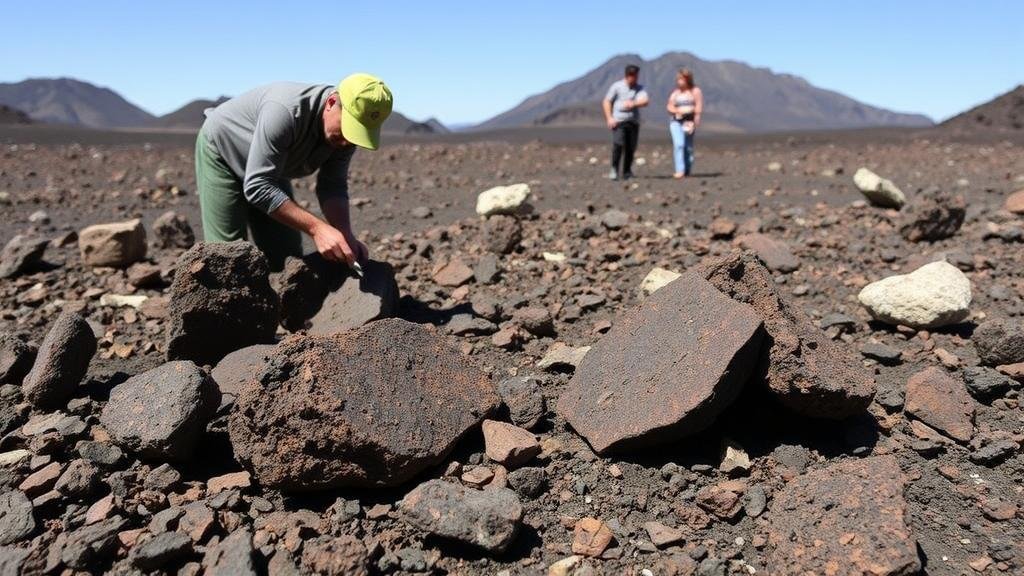Unearthing hematite and magnetite-rich rocks in the volcanic soils of the Caballo Mountains.
Unearthing Hematite and Magnetite-Rich Rocks in the Volcanic Soils of the Caballo Mountains
The Caballo Mountains, located in New Mexico, offer a unique geological setting that attracts rockhounds and mineral collectors alike. Renowned for their volcanic soils, these mountains host an abundance of mineral-rich deposits, particularly hematite and magnetite. This article details how to effectively seek out these minerals in the Caballo Mountains while providing insights into their geological significance and practical tips for successful collecting.
The Geology of the Caballo Mountains
The Caballo Mountains are primarily composed of volcanic rock, a remnant of geological activity that occurred millions of years ago. regions volcanic soils play a critical role in the formation of iron-rich minerals such as hematite (Fe2O3) and magnetite (Fe3O4). Understanding the geological background helps anticipate where these minerals might be located.
Hematite is an iron oxide mineral that typically forms via the oxidation of iron-bearing minerals, while magnetite is often found in igneous and metamorphic environments. Collectively, these minerals can form distinctive, yet fertile deposits in volcanic soils. Rockhounds will often find hematite displaying a metallic luster and a reddish-brown coloration, while magnetite may appear as a black, magnetic mineral.
Finding Hematite and Magnetite in the Caballo Mountains
When searching for hematite and magnetite-rich rocks in the Caballo Mountains, collectors should consider the following strategies:
- Study Geological Maps: Familiarize yourself with geological maps of the area, which can help identify specific strata where iron-rich minerals are likely to be concentrated.
- Look for Volcanic Features: Erosion of volcanic rocks often exposes mineral deposits. Focus your searches on areas with recent volcanic activity or erosion, such as lava flows or ash deposits.
- Search Closer to Old Mine Areas: Historical mining activities often indicate where mineral deposits are concentrated. Here, collectors can find tailings piles and other remnants that may contain hematite and magnetite.
Practical Tips for Rockhounds
Success in mineral collecting often depends on preparation and technique. Here are some practical tips for locating hematite and magnetite in the Caballo Mountains:
- Tools of the Trade: Equip yourself with a geological hammer, safety glasses, and a sturdy backpack. A magnet can also help differentiate between hematite and the magnetic properties of magnetite.
- Timing Your Hunt: The best times for mining and collecting are typically early morning or late afternoon when the sun is low, enhancing visibility and reducing glare on the rocks.
- Use GPS and Locate Sites: Prior to your trip, use GPS technology to mark potential sites and ensure safe navigation while hunting in rugged terrain.
Mineral Significance and Uses
Hematite and magnetite have significant industrial and scientific applications. Hematite, for instance, is commonly used in the production of iron and steel, accounting for approximately 70% of the world’s iron ore production. With growing industries worldwide, hematite remains a vital mineral.
Similarly, magnetite is used in various applications, from magnetic storage media to water treatment technologies, making it a crucial mineral in contemporary industrial processes. Collecting these minerals not only serves as an enjoyable hobby but also contributes to a deeper understanding of their economic importance.
Conclusion
The Caballo Mountains present an exciting opportunity for rockhounds and mineral collectors seeking hematite and magnetite-rich rocks. By examining geological maps, exploring volcanic features, and following practical collecting strategies, enthusiasts can enhance their chances of discovering these valuable minerals. Always remember to respect nature and the environment during your excursions, leaving no trace behind. Happy collecting!

